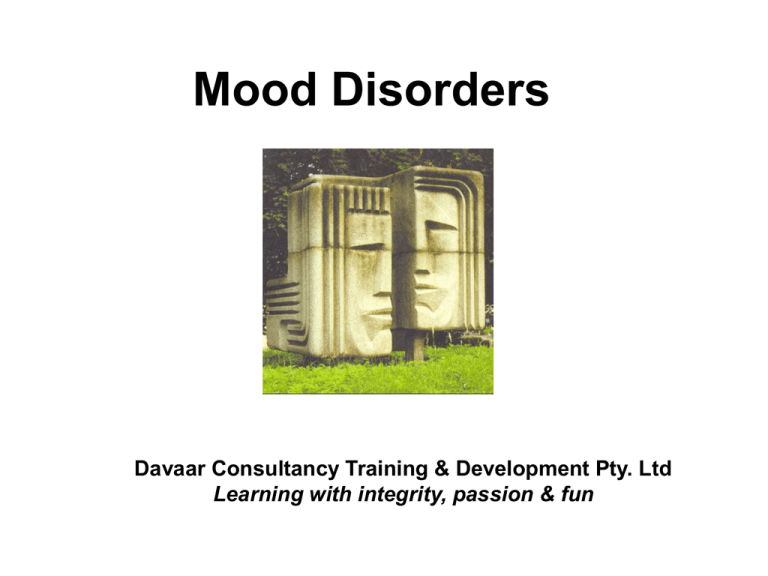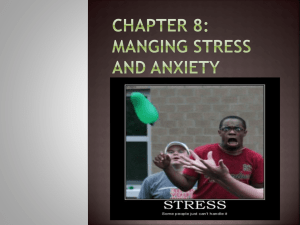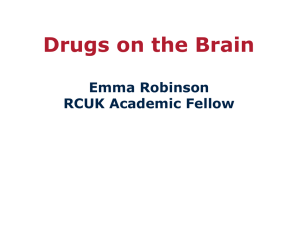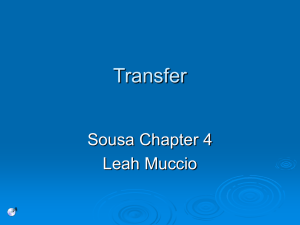
Mood Disorders
Davaar Consultancy Training & Development Pty. Ltd
Learning with integrity, passion & fun
1 CNE point
What is mood?
• mood is a pervasive and sustained
emotion that influences one’s perception
• normal variations in mood occur as
responses to specific life experience
• normal mood variations, such as sadness,
euphoria and anxiety are time limited but
when there is a sustained mood - mood
disorder (2 weeks)
Types of mood disorders
• primary mood disorders include both
depressive disorders (unipolar) and
manic-depressive (bipolar) disorders
• mood disorder due to a medical
condition
• substance induced mood disorders
Incidence
• WHO predict that for the 21st century mood disorders
will be the number one health problem
• (WHO predicts depression will be 2nd largest cause
of death and disability in world by 2020)
• major depression is currently the number one cause
of disability worldwide
• 300 million people in world today affected by
depression
• 20-30% of people with depression have a resistive
depression - prolonged disability (loss) and 25%
suicide
Diagnostic Tools
• DSMIV - defines a mood
disorder as “recurrent
disturbances or alterations in
mood that cause
psychological distress and
behaviour impairment”
Depression
Depression categorised as:
ICD10
mild - moderate
DSMIV dysthymic disorders – major depression
The Black Dog Institute Hierarchical Model
Internet. May 2005
Depressive Subtype
Psychotic
melancholia
Non-psychotic
melancholia
Non-melancholic
depression
(major depression)
Clinical feature
Neurotransmitter
Psychotic
features
DA
Psychomotor
disturbances
NA
___________
Mood disorder
5-HT
Non-melancholic depression = underpinned by serotenergic dysfunction
Melancholic & psychotic depression = increased and more dominant
noradrenergic /dopaminergic contributions respectively
Non-melancholic depression
Social impairment
More than
2 weeks
Individuals with NMD tend to exhibit the following
features:
• absence of psychomotor disturbances
• depressed mood is reactive
• no morning changes in mood/energy
Melancholic Depression
Social impairment
Psychomotor disturbance
(retardation, agitation & cognitive disturbance)
Key features:
• anhedonia
• non-reactive mood
• mood & energy worse in the morning
• profound & uncharacteristic “emptiness & inactivity”
• observable psychomotor disturbance
Epidemiology
• risk of depressive disorder range from 7-12% in
men and 20-25% in women
• 2,500 youth suicide a year second most common
death in adolescence
• depression is often associated with a variety of
medical conditions: (endocrine, cardiovascular,
neurological, autoimmune, viral and substance abuse)
• prevalence is unrelated to ethnic or cultural backgrounds
• 25% experience recurrence in first six months after
episode 50-75% have recurrence in five years
Risk Factors
• depression is so common that it is
sometimes difficult to identify the risks
• prior history of depression
• family history
• lack of social support
• stressful life event
• current substance abuse
• medical comorbidity
Causes
Three major causes of depression often
cited: genetics, biochemical and
environmental
Genetics: emphasis placed on the role of
dominant of faulty genes in the production
of various modes of depression
Biochemical: emphasis placed on the role of
decreased numbers of neurotransmitters at
receptor sites in brain
Environmental: emphasis placed on the extent to
which various clusters of factors in a person's
physical and social environment come together
to produce the symptoms
Diet – according to Sanchez Villegas et al, (2009)
a Mediterranean diet may protect against
depression. This diet is high in vegetables, fruits
and nuts, cereals, legumes and fish, has a high
monounsaturated to saturated fatty acids ratio
and includes moderate amounts of alcohol. The
Mediterranean diet is thought to reduce
inflammatory and metabolic processes that may
be involved in depression
Other models have also been proposed:
disease model, psychodynamic (personality),
behavioural and social / learning model
(McLoughlin, 2002; Parker & Ray, 2002)
Behavioural position holds that depression occurs
primarily as the result of a severe reduction in
rewarding activities or an increase in unpleasant
events in one’s life manifesting the mood disturbance
Learnt responses: some people exposed to
repeated losses or stresses may learn that life is
difficult and often feel helpless and depressed
Personality
Anxious / worrying: reflecting high levels of internalised,
on-going anxiety
Irritability: reflecting high levels of externalised, ongoing
anxiety
Social avoidance: individuals avoid socialising
Personal reserve: individuals are uncomfortable about
sharing their feelings or opening up to others
Self-criticism: reflecting ongoing low self-esteem and selfworth
Perfectionism: reflecting self-imposed high standards
Interpersonal sensitivity: sense of self worth is highly
dependent on how they see other people reacting to
them
Self-focused: focus more on own needs than on the needs
of others (Black Dog Institute, 2005)
Developmental theorists postulate that
depression may be the result of loss of parent or
separation or lack of emotionally adequate
parenting. Also developmental milestones (trust
vs mistrust)
Findings from Parker & Ray (2002),
two dominant factors correlated to
presentation of depression – “anxious worrying
and intraversion”
• Anxious worrying/intraversion usually evidenced
where family hx of anxiety
• Individual demonstrated behavioural inhibition
shyness in childhood - high lifetime rate of both
formal anxiety disorder and anxious/fearful
personality characteristics
Taking a closer look at some of those symptoms –
usually seen in a major depression
The physical, cognitive, emotional
and psychotic
Physical
• change in appetite (weight gain/loss)
• sleep disturbance (initial, middle, terminal
insomnia)
• sexual dysfunction
• decreased motivation/interest
• psychomotor retardation / agitation
Cognitive
• worthlessness, guilt,
• recurrent thoughts of death, suicidal ideation
thoughts and or plan
• sadness, hopelessness, anxiety preoccupation
with death
• loss of sense of self-control
• poor concentration / memory loss
Mood
•
•
•
•
•
sad
“depressed”
“black hole”
“crying”
“numb”
Psychotic Symptoms
• delusional thinking
• hallucinations
• thought disorders
(blocking, retardation,
insertion etc)
(Moyle 2002)
Famous Folks
Abraham Lincoln, Adam Ant,
Billy Joel, Heath Ledger
Harrison Ford, J.K. Rowling,
Tennesse Williams, Vincent van Gough
Treatment of depression
• often treated in
community
• hospitalisation only
occurs when
symptoms are such to
cause concern for
family, GP,
psychiatrists, patient
(inability to function,
suicidal thoughts /
intent)
Scenario
Consider 3 stages of management:
Acute Stabilising Follow up
Goals of inpatient care - acute
• maintain safety,
• reduce signs &
symptoms of
depression
• restore level of
functioning
• Routine Mental State
Assessment
• Maintain safety
• Adequate sleep
• Hydration and
nutrition
• Exercise
• Diversion
• Therapeutic use of
self
Stabilising
• Monitoring medication regime (effects /
side effects)
• Ongoing support:
– Individual counselling
– Group Support
– Psycho education (signs, symptoms, triggers,
intervention)
– Sleep, diet, safety
Follow up
• monitoring medication
compliance / adverse effects
• cognitive therapy
• behavioural therapy
• group therapy
• family support and education
• counselling
• education
Pharmacology
• depression is often considered to be caused
by an over response or under response
somewhere in the process of
neurotransmission
• antidepressant pharmacology effects process
of cell to cell communication at the synapse in
specialised medians - release, blockade,
receptor sensitivity, blocked re uptake within
neurotransmitters
Pharmacology
• Mono-axine oxidase inhibitor (MAOI’s) successful
in 39% pop –(increases noradrenaline and
serotonin in the brain –
Parnate, Marplan)
• Tricyclic antidepressants (TCA)(introduced in the
1950’s - Prothiaden, Amitriptyline,
Clomipramine, Doxepin, Imipramine)
• Selective Serotonin Reuptake Inhibitors
(SSRI’s)(Citalopram, Fluoxetine, Paroxetine,
Sertraline)
• Serontin and Noradrenaline Reuptake Inhibitour
(SRI) (Venlafaxine, Nefazodone, Tramadol)
Cognitive Behavioural Therapy
• CBT teaches skills which help people cope
with events
• components include recognising there is a
connection between thought, mood, and
behaviour. Learning to monitor negative
self talk ie “I can’t do this”
• challenge thinking, interpret situations so
that reactions are more realistic
E.C.T. & T.M.S
Electro Convulsive Therapy
•initially used in the 1930’s
• usual course 6-12 treatment (3 x weekly)
• procedure does not cause brain injury in adults
• uni or bilateral
• consent form
Famous folks who have had ECT: Janet frame, Judy Garland,
Ernest Hemingway, Sylvia Plath, Lou Reed, Yves Saint-Laurent, Vivien Leigh
Transcranial Magnetic Stimulation
• noninvasive method to excite neurons in the brain, weak electrical
currents are induced in the tissue by rapidly changing magnetic fields
Questions to consider
• Why is this person depressed? (personality
type, Hx)
• What type of depression?
• Why now? (life events, triggers)
• Are they safe? (risk assessment)
• What needs to be done now? (priorities)
• How well do I know the patient? (therapeutic
alliance)
• Who else is there for them (supports available)
• Who else do I need to involve? (referral
needs)
BIPOLAR AFFECTIVE
DISORDER
Mania
Hypomania
Melancholia
MANIA
Manic behaviour is
•
•
•
•
•
•
•
•
The opposite of depressed behaviour
motor activity is increased
hyperactivity
restlessness
increased spending
driving recklessly
foolish business investments
sexual disinhibition, increased libido
•
in females make up may be excessive and poorly applied
• both male and female wear bright coloured clothes may not
match, (may be seductive)
• decreased attention to personal hygiene
• disruptions in the circadian rhythms therefore there is a
perception of decreased need for sleep (even though the
body may be exhausted)
• disturbed sleep
• excessive energy no time to sit and eat (the lack of sleep and failure
to eat may become life threatening)
• individual fails to notice minor ailments or physical
complaints – (may be susceptible to infection &
illness)
Mood
• during manic episodes the individuals mood is
euphoric (overly cheerful, excessively
enthusiastic and presents as “high”)
• may exhibit a wide range of mood swings labile
laughing/crying
• becoming irritable and angry when desires are
thwarted
• infectious quality about mood / unwarranted
optimism
Consider: there may be a feeling of inadequacy and
inferiority that lurks behind his euphoria (psychoanalytical
perspective)
Cognition
• thought processes in
•
•
•
•
•
mania are accelerated
easily distracted
pressured speech ….
flight of ideas
communication may be
humorous (full of jokes,
puns, play on words)
may become theatrical
sounds rather than
meaning govern word
choice (clanging)
• grandiose thoughts (I’m
the queen, “I have close
links with Jesus”)
• judgment & insight
impaired
• may give away valued
possessions (thinking
they no longer need /
want them)
Social
•
•
•
•
•
self-esteem unrealistically inflated
over-confidence in one’s ability
increased social activity
intrusive, domineering approach to others
often involved in excessive planning and
multiple activities
Pressure on partners
•
•
•
•
•
•
•
“being alone together” (van der Voort, et al 2009)
experienced heavy burdens and difficulty coping (
being solely responsible, being alone with one’s
feelings)
absence of sex and intimacy – worry about the future
being forced to give up their work
perform new roles in the relationship
feeling exhausted
choose to leave relationship
Spiritual
• in mania individuals may come to value
the “highs” in their lives
• may choose not to take their medication
(preferring to be high / or because of side
effects)
• life more bearable when high rather than
when depressed
Interventions
Maintain safety
Interventions
• Pharmacology:
– mood stabilisers (lithium, valporate,
carbamazepine)
– anti depressents (effexor, cipramil, MAOI’s
parnate, imipramine)
– antipsychotics (olanzapine, clozapine,
risperidone, quetiapine)
– be mindful of interactions, side effects of
medications
• limit set on inappropriate
behaviour
• reduce environment
stimuli
• supervise administration
of medications
• ensure adequate sleep
and nutrition
• help client focus on one
topic during conversation
• ignore, distract from
grandiose thinking
• present reality (time place
& person)
• consider one staff
member involved in
discussions
• provide information about
diagnosis,
• medication and
treatments (when patient
demonstrating insight)
• promote a realistic sense
of self-esteem
Famous Folks
•
•
•
•
•
Richard Dreyfuss
Carrie Fisher
Marilyn Munroe
Charles Dickens
Robert Louis
Stevenson
• Mark Twain
•
•
•
•
Ozzy Osbourne
Winston Churchill
Florence Nightingale
Issac Newton
Suggested readings
•
•
•
Gomez, G.E. (2001), Lithium Treatment. Present & Future. Journal of Psychosocial Nursing, 39
(8), 31-36.
Pebbles, C., & Porter, R. (2002). New treatments for bipolar disorder. Current Therapies, Oct 2126
Scheick, D.M. (1995). Therapeutic Insight: From family to practice. Journal of Psychosocial
Nursing, 33 (7), 31-33.
References
• Black Dog Institute (2005). Internet: www.blackdoginstitiute.org.au DSM IV
• McLoughlin, G. (2002). Is depression normal in human beings? A critique of the evolutionary
perspective. International Journal of Mental Health Nursing, 11, 170-173.
• Moyle, W. (2002). Unstructured interview: challenges when participants have a major
depressive illness. Journal of Advanced Nursing, 39 (3), 266-273
• Parker, G., & Roy, E. (2002). Examining utility of a temperament model for modelling nonmelancholic depression. Acta Psychiatrica Scandinavia, 106, 54-61
• Sanchez Villegas, A., et al. (2009)..... Archives of General Psychiatry, 66, 1090-1098
• van der Voort, T.Y.G., Goossens, P. J.J., & van der Bijl, J.J. (2009). Alone together: A grounded
theory study of experienced burden, coping and support needs of spouses of persons with a
bipolar disorder. International Journal of Mental Health Nursing, 18, 434-443.
Websites
• www.sane/org/snapshots
Davaar details
Davaar Consultancy Training &
Development Pty. Ltd.
PO Box 37, Laidley, Qld. 4341
Web: www.davaar.com.au
Email: wendy@davaar.com.au
colleen@davaar.com.au
(m) Wendy: 0411385573
Colleen: 0431655702








